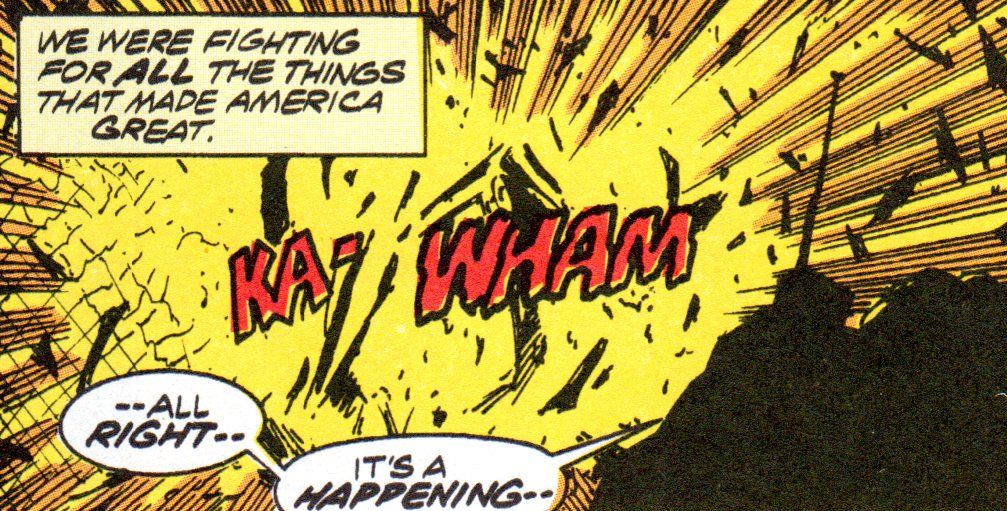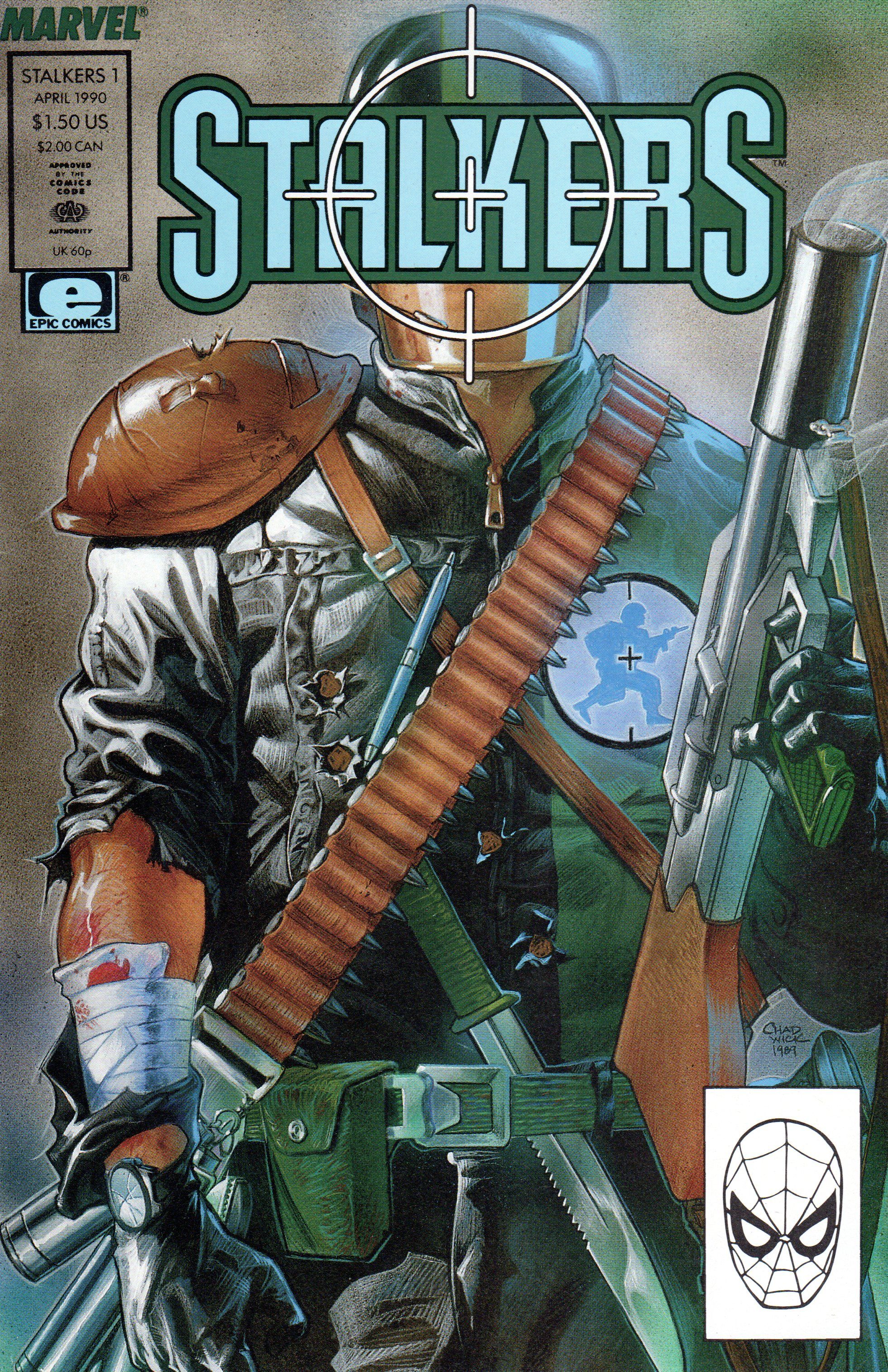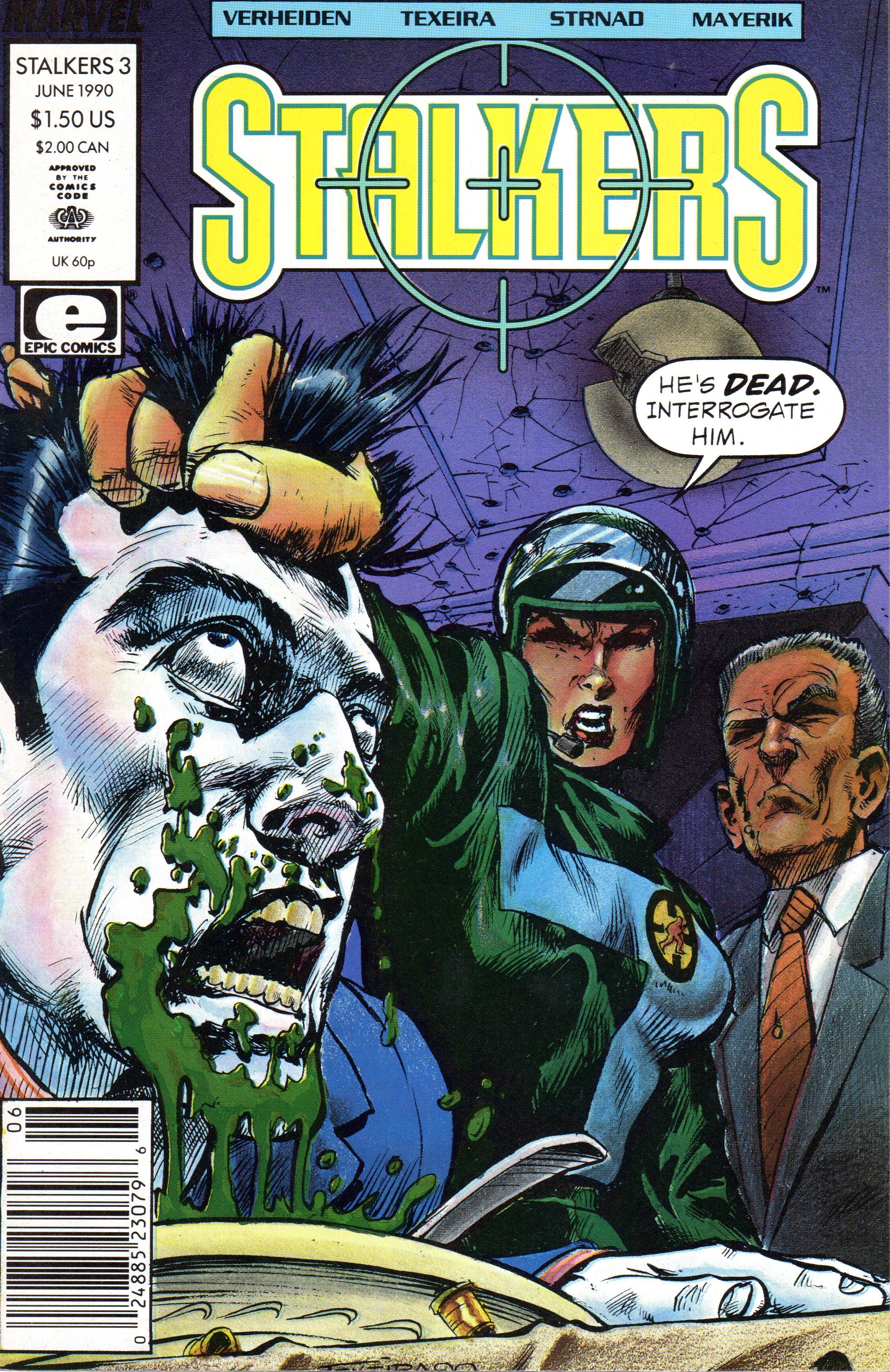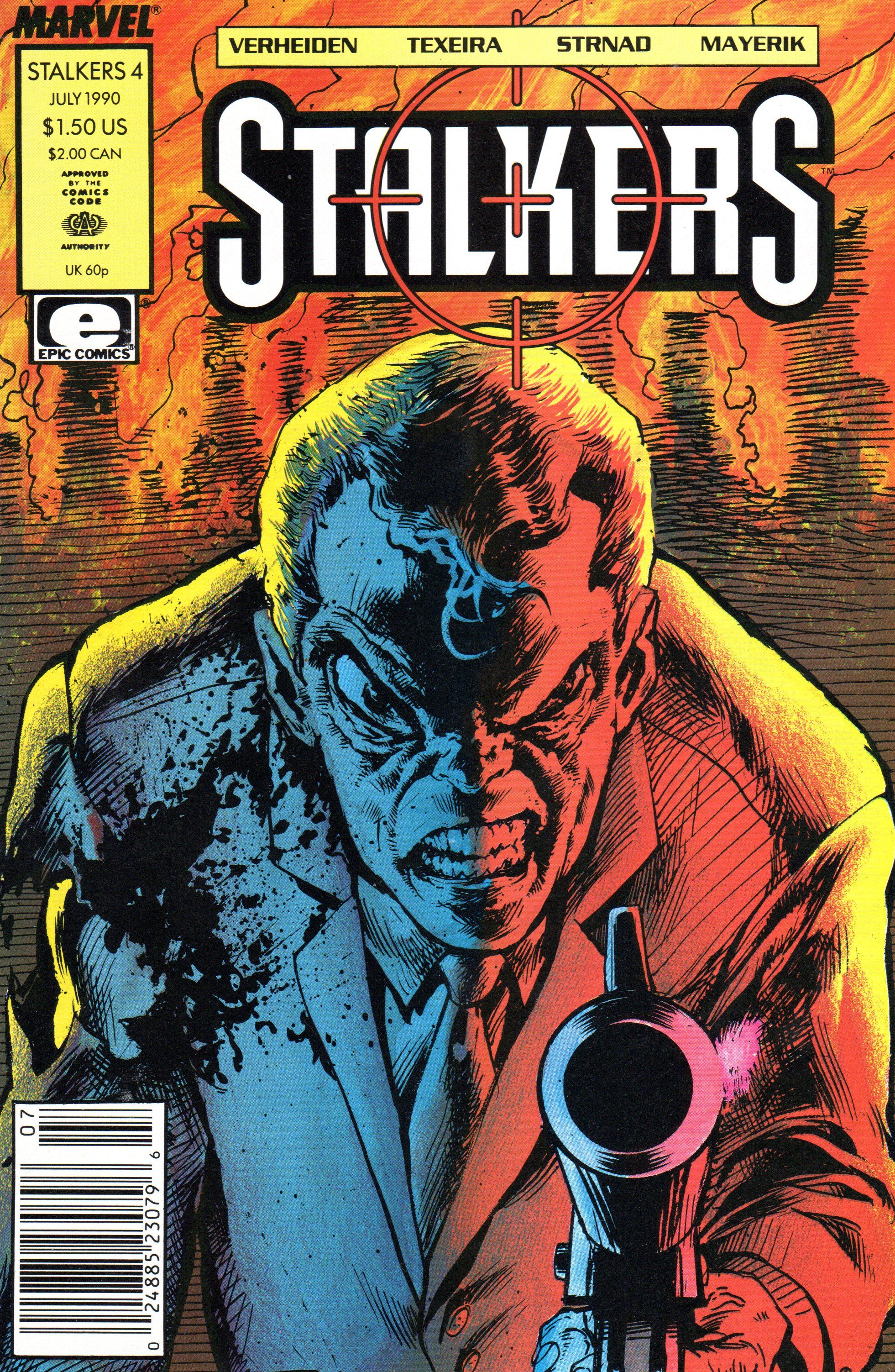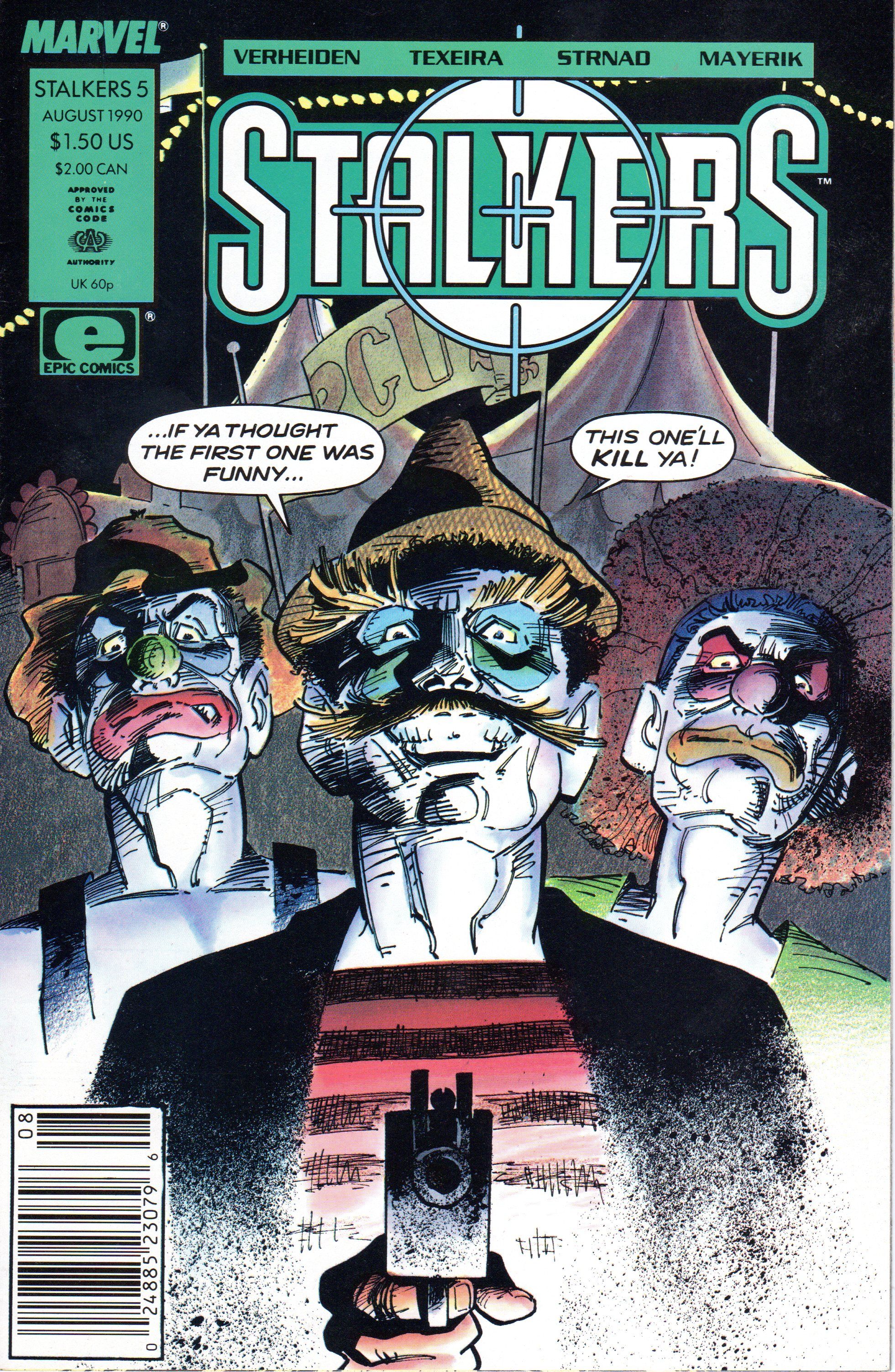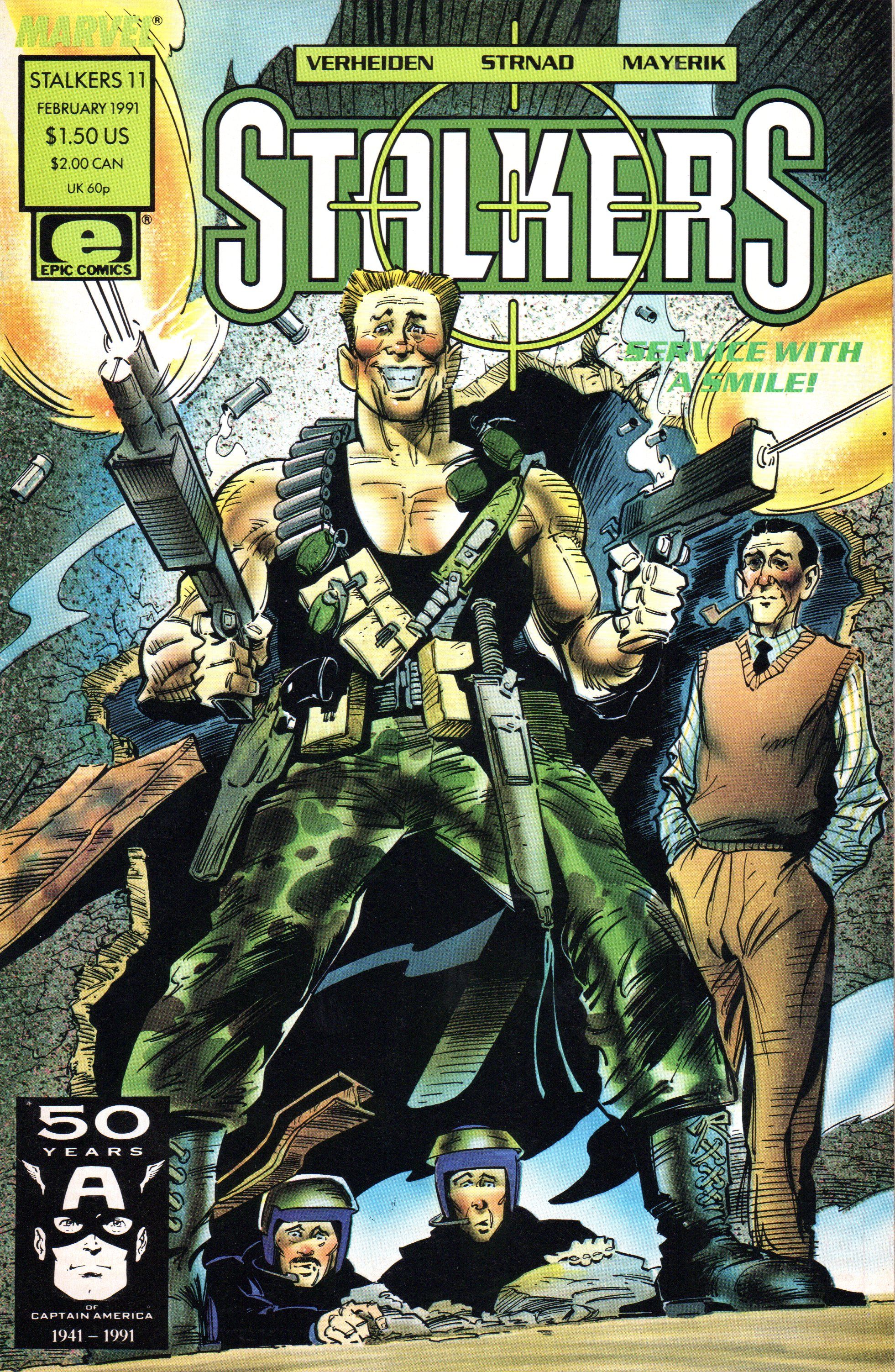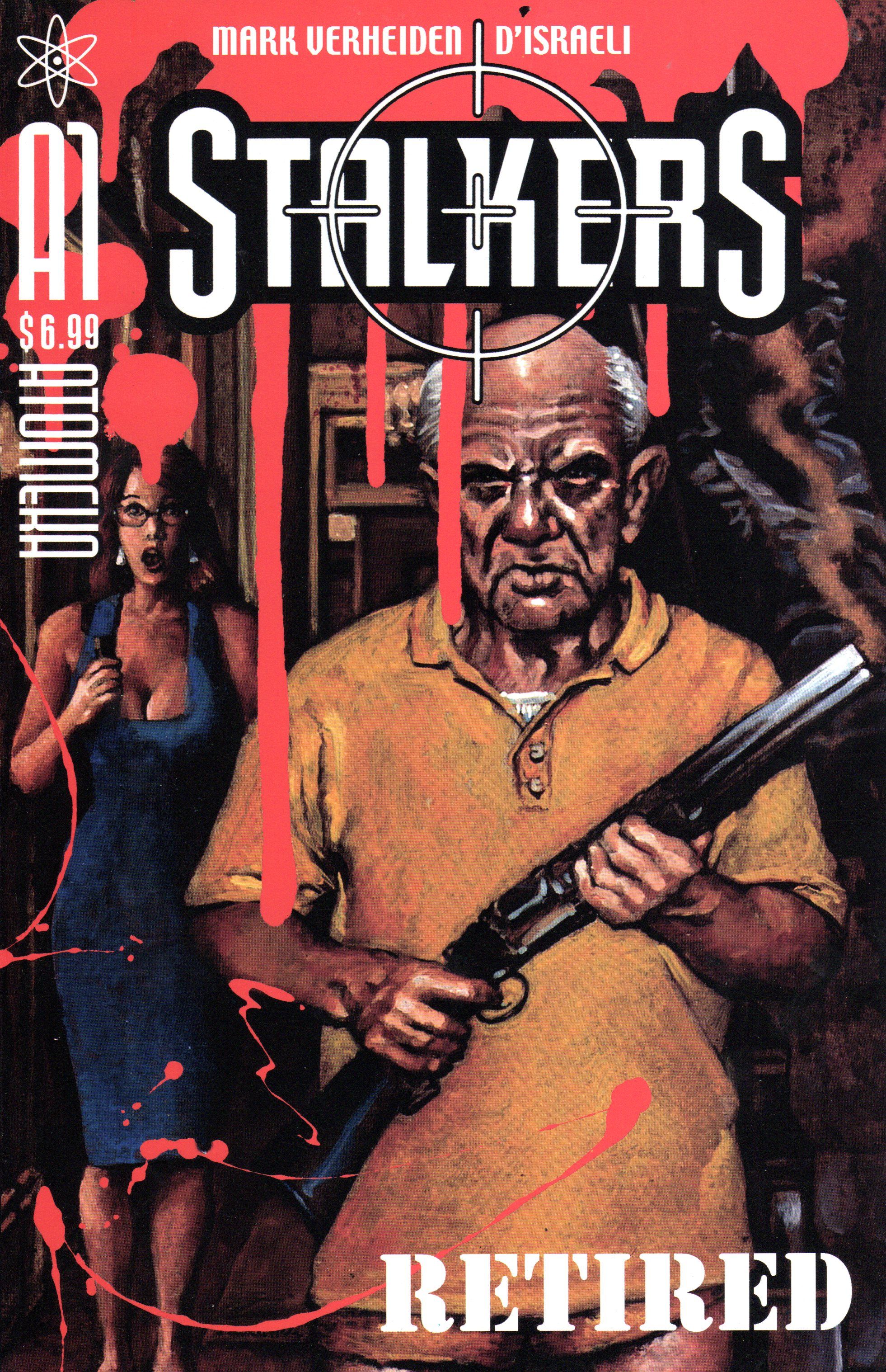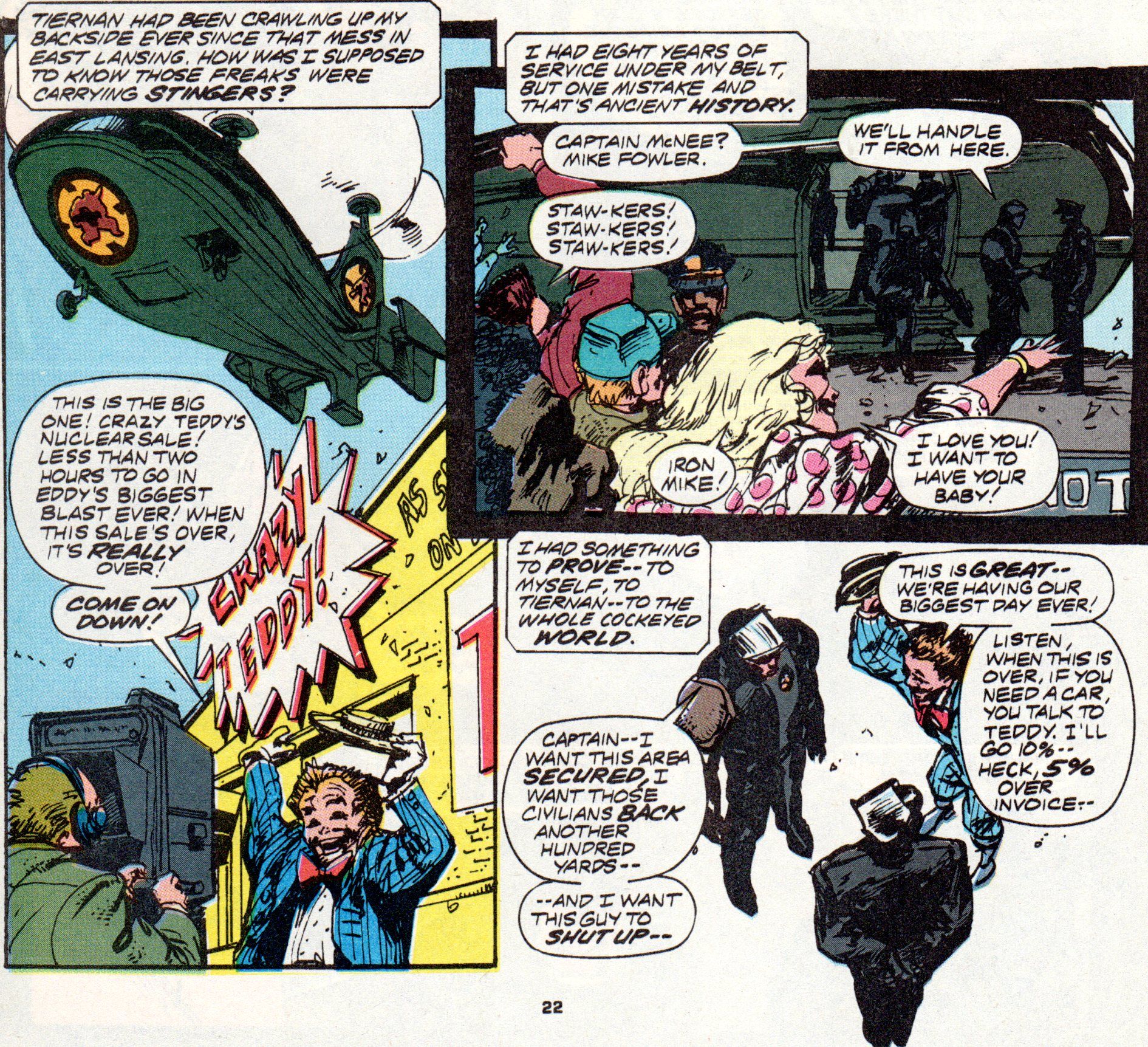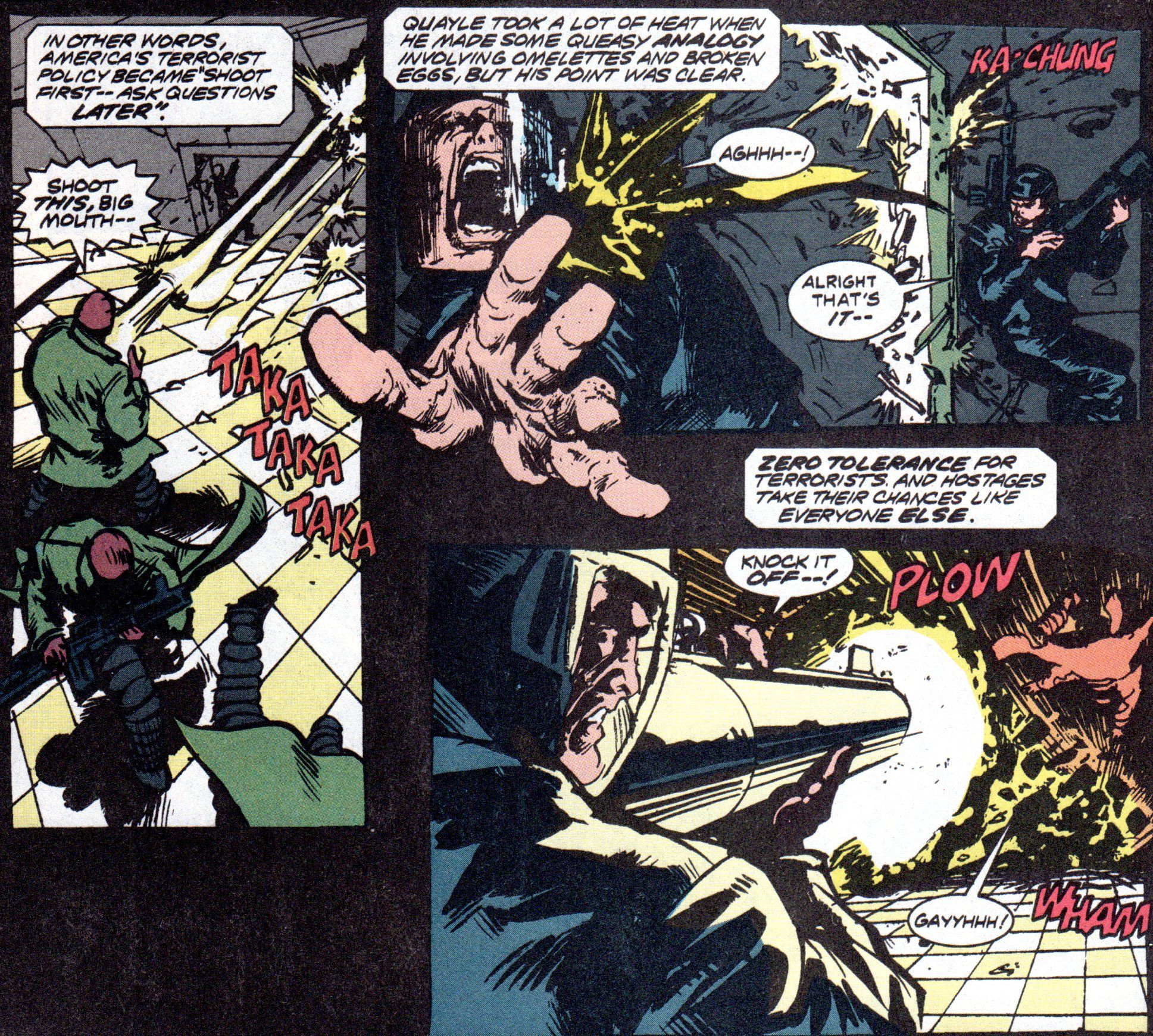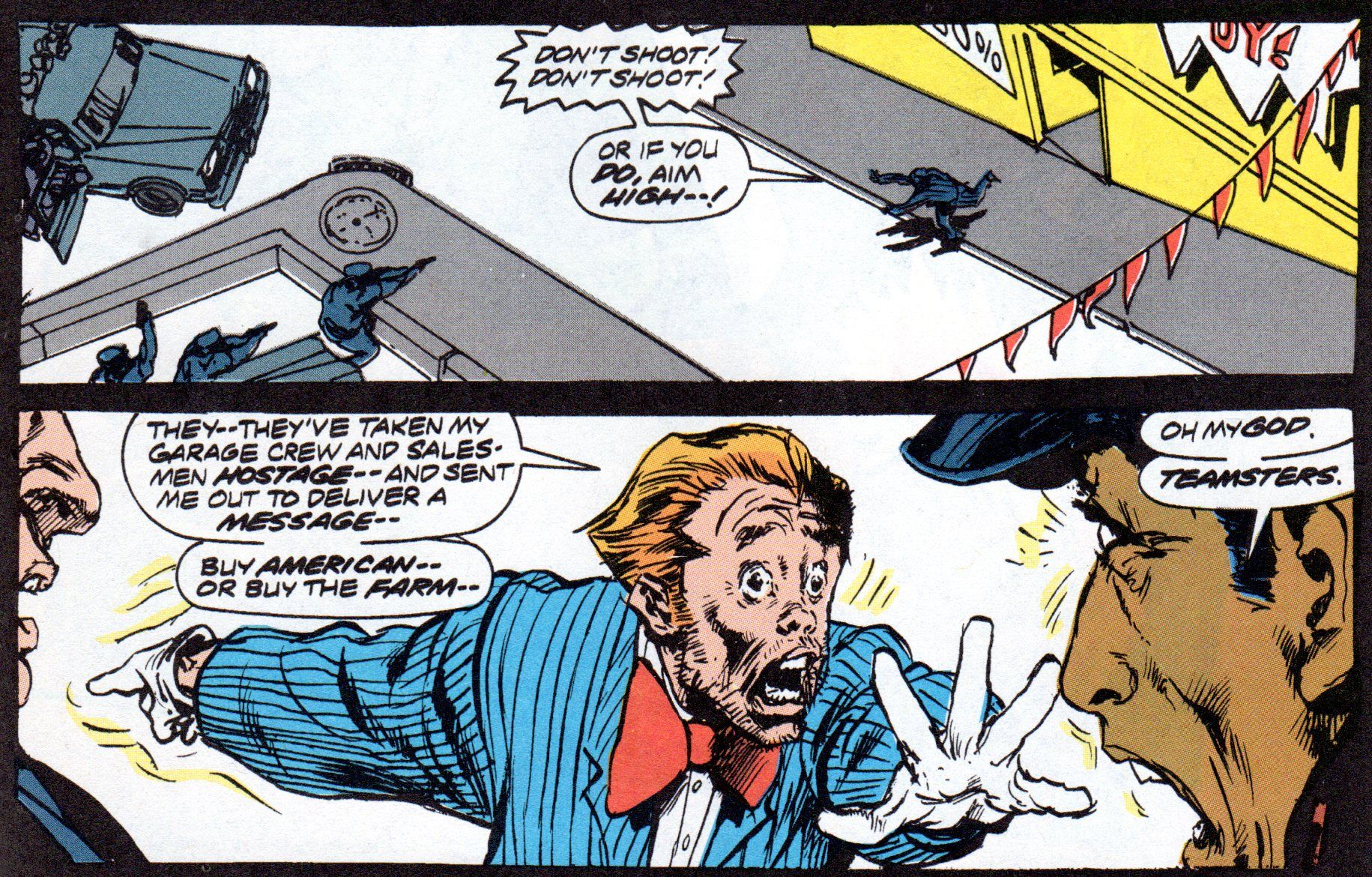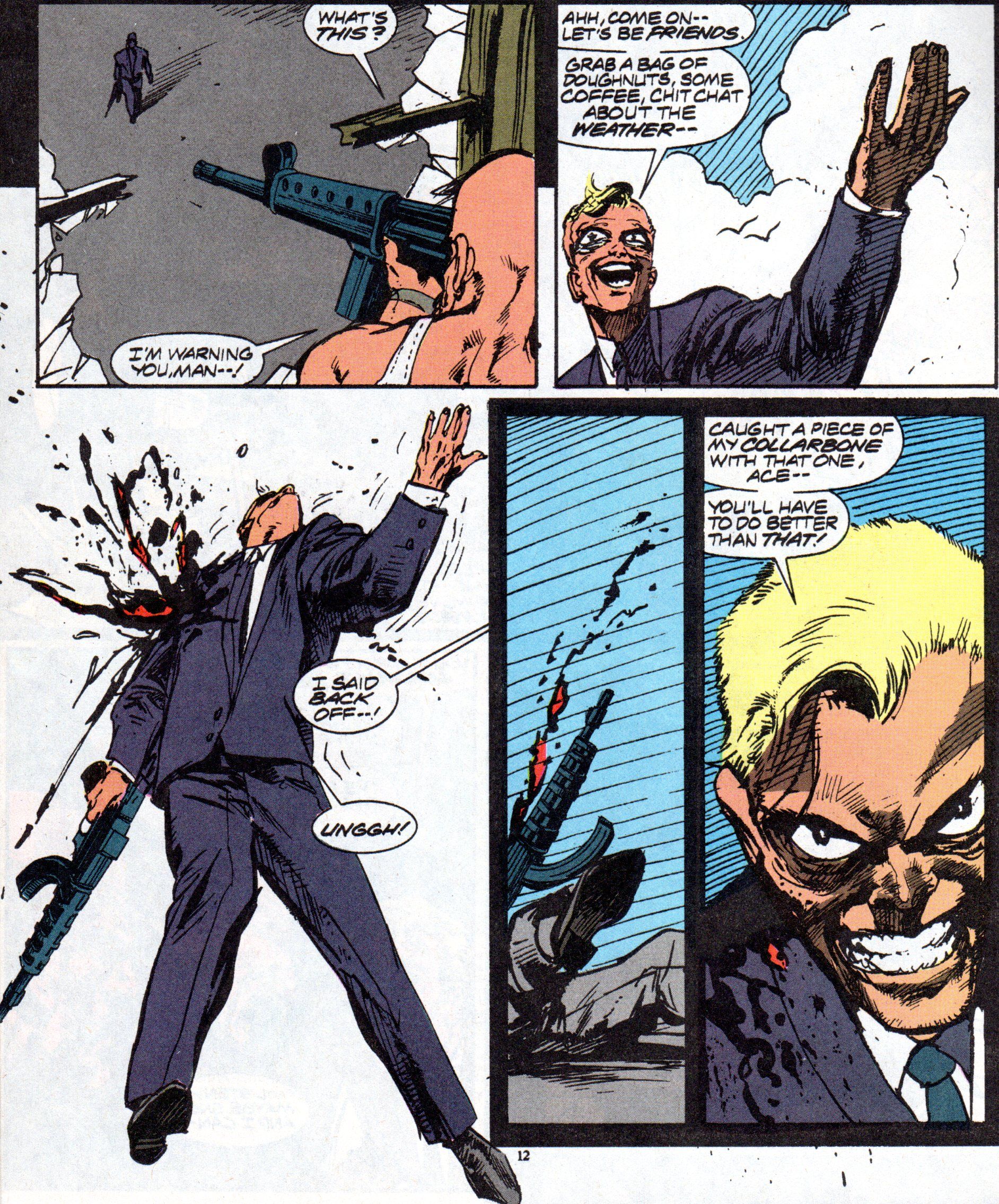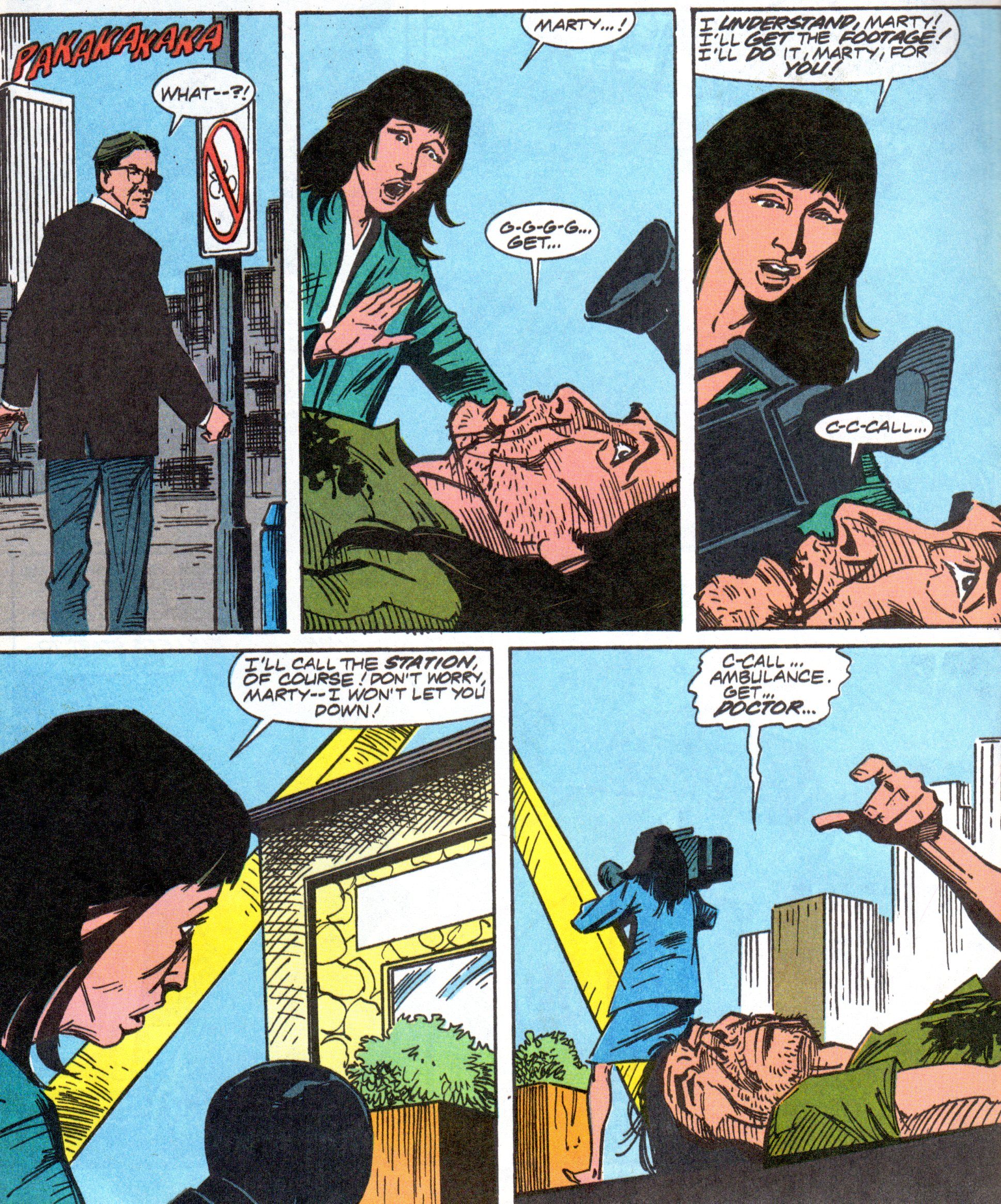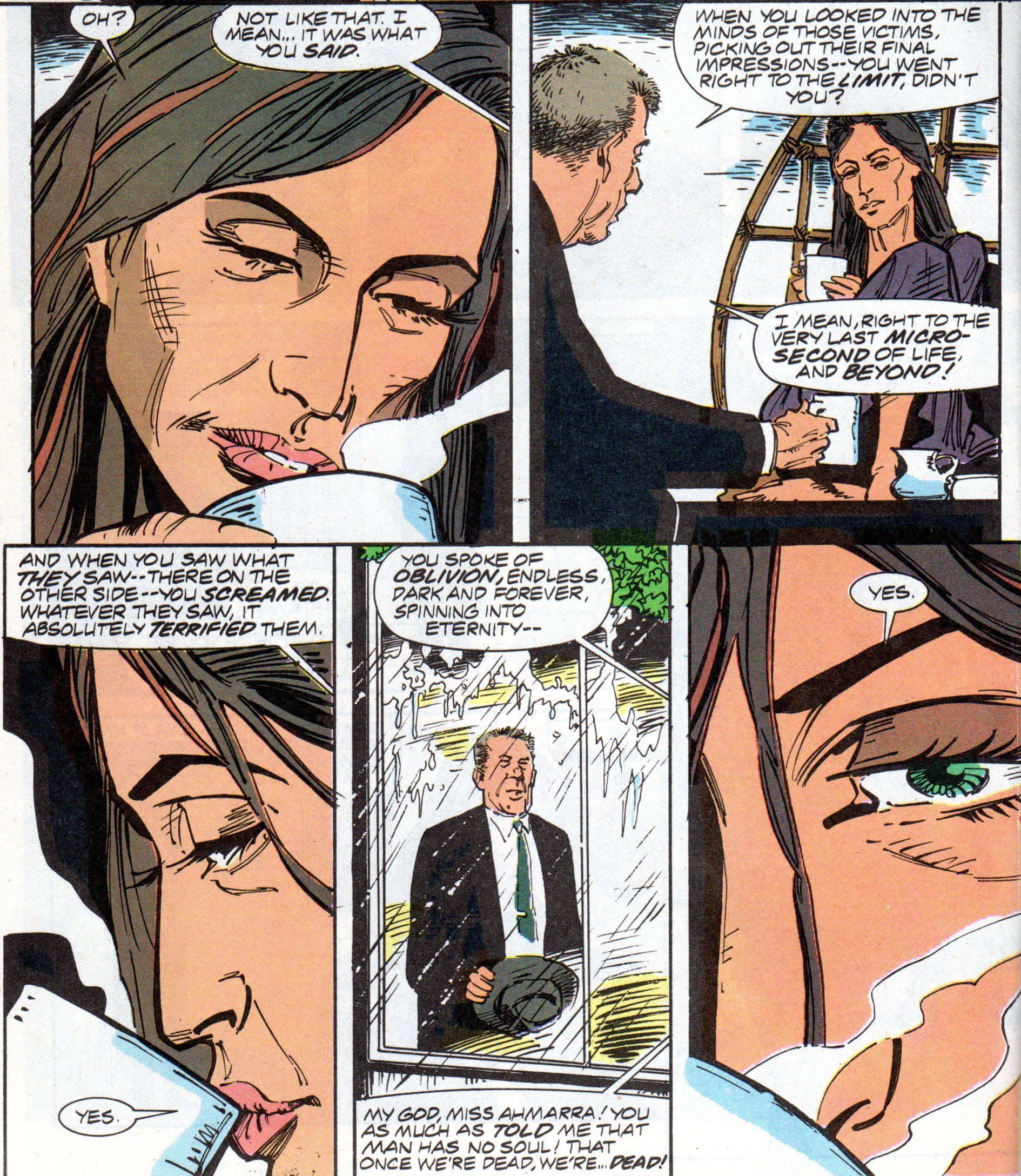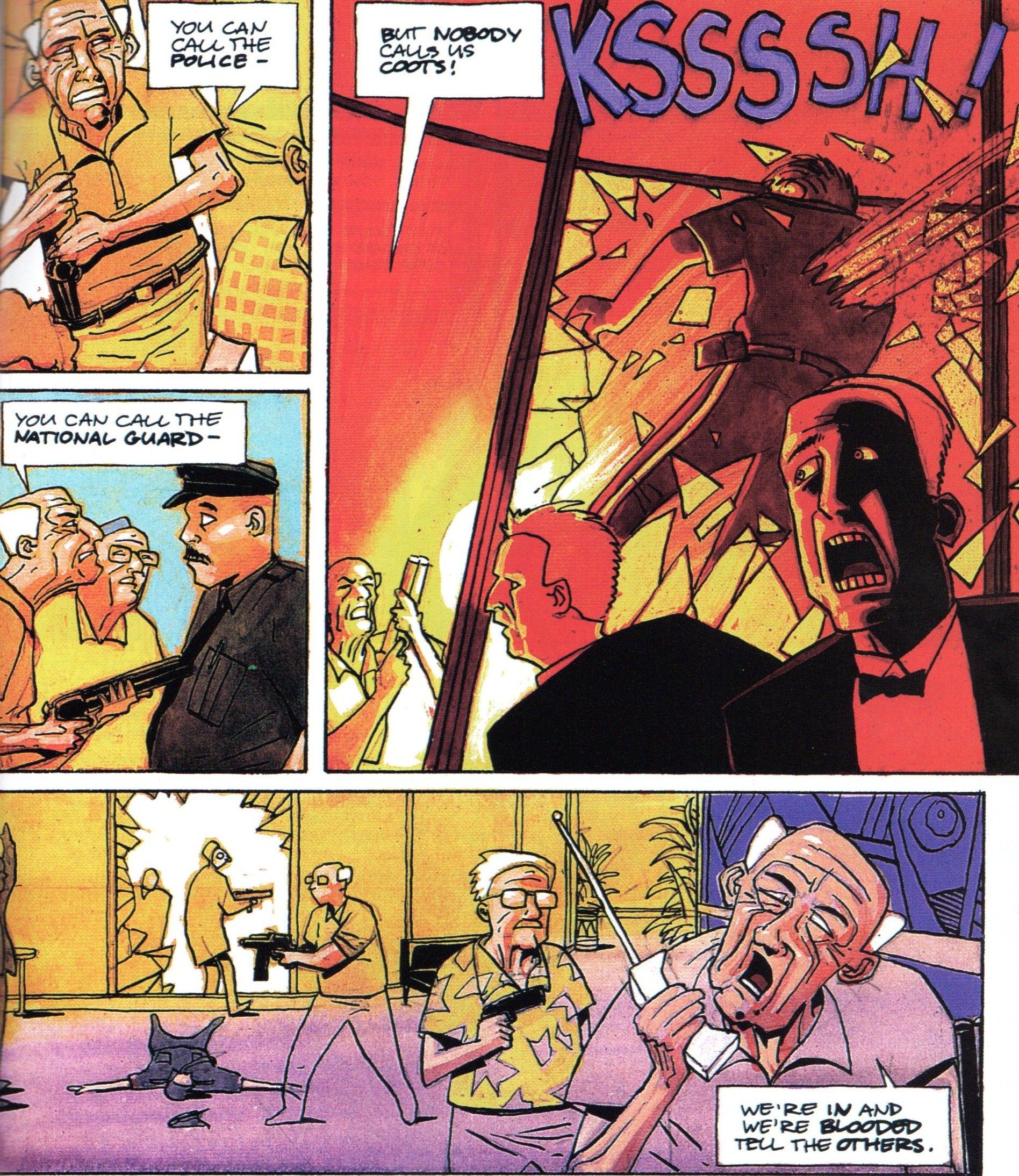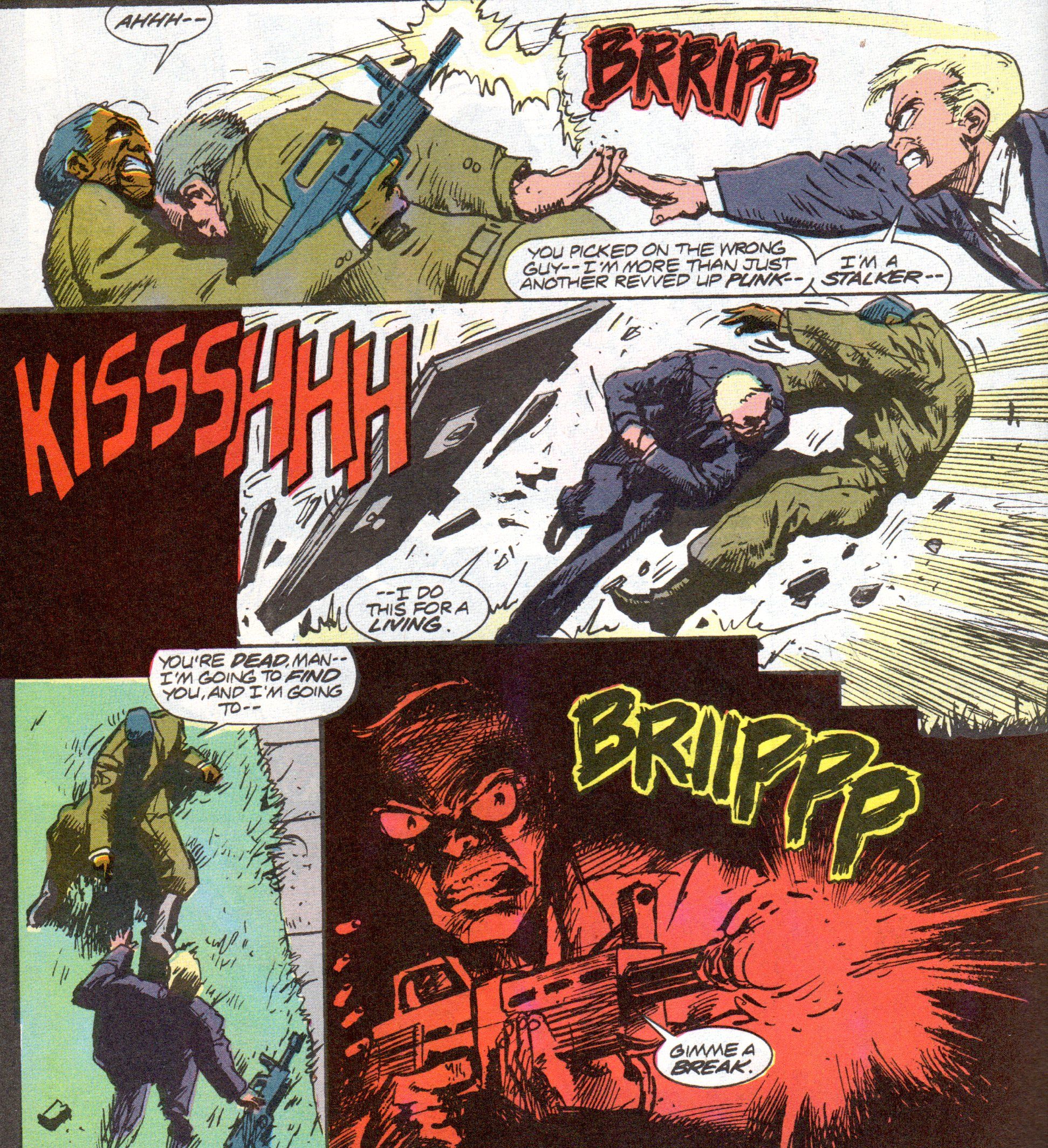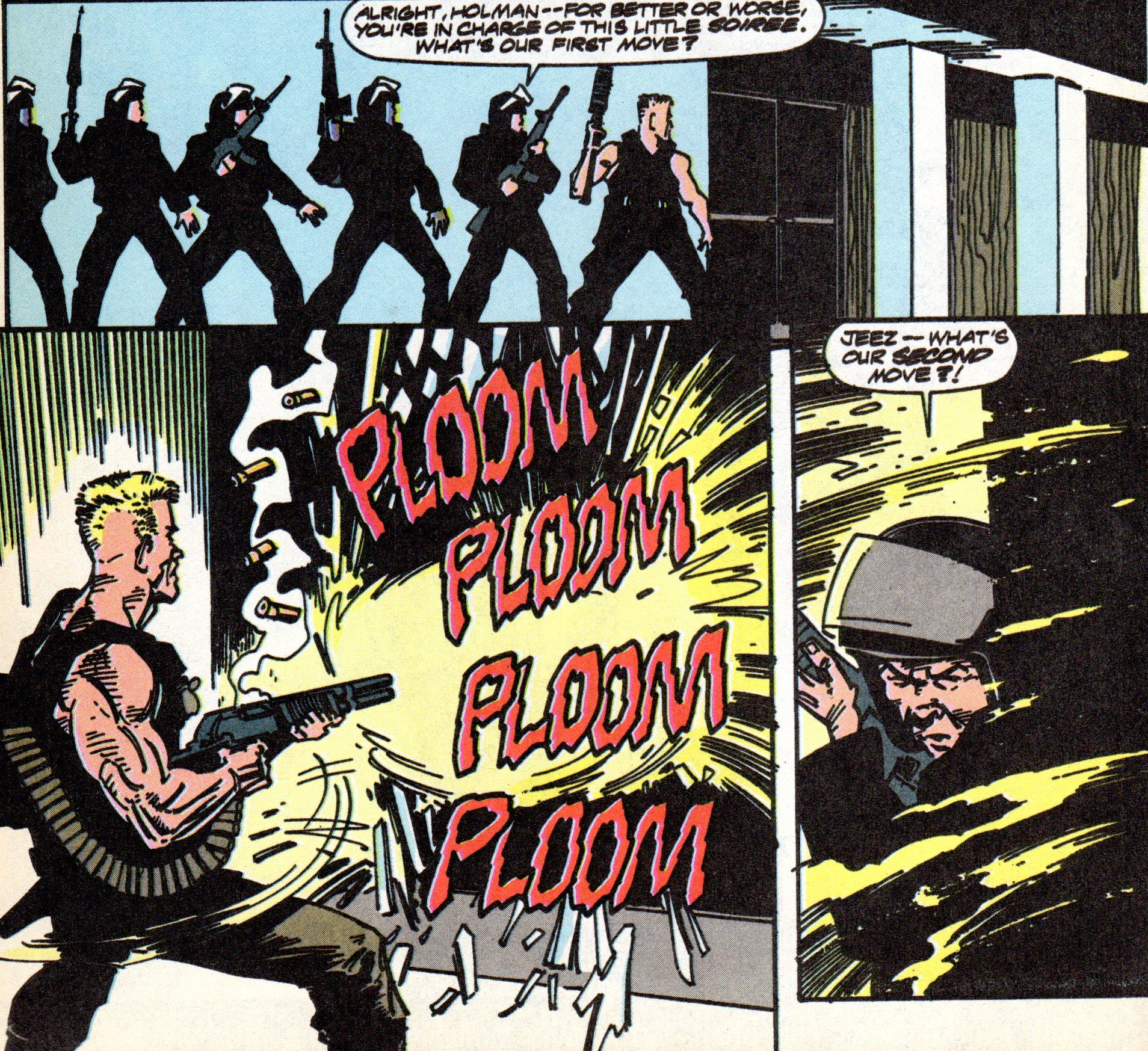Admit it: You thought Starman was next, didn't you? Well, so did I, and then I re-read this underrated gem. Let's dig into it!
Stalkers by Jan Strnad (writer, issues #1-12), Mark Verheiden (writer), Mark Texeira (artist, issues #1-7), Val Mayerik (artist, issues #3-9, 11-12), Mike Parobeck (penciler, issue #10), Jeff Johnson (penciler, issue #10), D'Israeli (artist/painter/letterer, "Time to Retire"), Chris Ivy (inker, issue #10), Christie Scheele (colorist), Ken Lopez (letterer), and Pat Brosseau (letterer, issue #10).
Published by Marvel/Epic and Atomeka Press, 13 issues (issues #1-12 of the ongoing and "Time to Retire"), cover dated April 1990 - March 1991 (ongoing) and January 2005 ("Time to Retire").
A few minor SPOILERS lurk below, but no big ones. Feel free to read on!
When you're writing satire, you can go one of two ways. You can make the satire incredibly subtle, to the point that it might be difficult to discern that it actually is satire. This gives you an ex post facto defense when people "misunderstand" your work - you or your defenders can always claim it was satire all along (this is known as the "Frank Miller defense").
Or you can make the satire incredibly broad, so that no one can miss the fact that it's satire. Either can be brilliant, although the latter kind of satire seems to have a lesser reputation simply because it's so obvious. Transparency, however, can act as a buffer against those who would misinterpret the work as "serious" and therefore possibly reprehensible. Obvious satire precludes that argument.
Stalkers is of the latter kind; there's never really any doubt that it's a satire. What makes it brilliant, however, is the fact that it's not only a satire, it's a fairly prescient look at where society was heading in 1990 and where we find ourselves today. It's amazing how much Strnad and Verheiden get right, or at least close, to how society would look in the near future. They set their book in 1999, so they're off on some of the dates, but almost 25 years later, it's impressive how much they wrote into the comic has become a chilling reality. Stalkers takes absolutely no prisoners, which is another reason it's a good satire. Too often, we see writers start off with a laser-like focus on satirizing every aspect of their world, but by the end, they've gone a bit soft and don't follow through. Strnad and Verheiden never do that, despite the few moments of genuine humanity in Stalkers. Those moments flow naturally from the narratives, and they are done well enough that they make the sharp cuts of the satire all the more devastating.
As good as the series is, Strnad and Verheiden kick it off with a superb first two issues that stand slightly above the rest. These two issues form the only issue-length stories in the series; following this, the issues would be split into two separate stories, with Strnad writing one and Verheiden writing the other.
In issues #1-2, however, they focus on introducing the Stalkers and giving them a problem to solve. Stalkers, Inc. is a private police force, charging for their services when the regular cops don't have the manpower or resources to solve the problems. In these two issues, Strnad and Verheiden tell us everything we need to know about the world of 1999, and even though it's very close to the world depicted in Paul Verhoeven's brilliant satire, RoboCop, it's still impressive how well the writers create the world from the ground up. In the first story, a fired automobile executive breaks back into his former factory with a nuclear bomb. He's bitter because he negotiated a merger with a Japanese company and was then let go. His team of terrorists also takes over a used car lot in downtown Detroit as a distraction for the Stalkers, whose attention is elsewhere when he goes to his factory. A team led by "Iron" Mike Fowler, who is of course a crusty old Stalkers veteran coming off a suspension, takes his team to the used car lot and then to the car factory. Strnad and Verheiden do a wonderful job building the tension throughout the two issues - they begin the series at the end, and we know some bad things have happened, but we don't know how bad it is, and the writers do an excellent job getting us back to that point. It leads to an incredible climax, where one of the few emotionally powerful scenes takes place and pays off one of the few humanistic moments in the comic. It's a tremendous story.
While the actual story is excellent, Verheiden and Strnad's commentary on society is even better. In 1990, the idea that the Japanese would take over the American automobile industry wasn't shocking, but Strnad and Verheiden bring in the idea of the older generation getting forced out without compensation, which has become more of a theme over the past two decades. Crazy Teddy, whose used car lot gets taken over by the terrorists, comes out and tells the police the bad guys have a message:
Once Teddy recovers, he decides to hold a "nuclear sale," and when the Stalkers blow up his storeroom, he bemoans that they didn't aim at the cheaper models. Meanwhile, merchants just outside the police line are selling Stalkers merchandise, and the people are buying them up.
At one point we see one of Teddy's commercials, and his tagline is: "Where the deals are so hot, they're radioactive!" Meanwhile, when the Stalkers blow up the showroom, Fowler narrates that President Quayle signed an executive order putting containing a terrorist event over the lives of hostages, which means those captured in a terrorist attack "take their chances like everyone else." When they manage to capture a terrorist alive, Fowler tells him that his rights have been suspended thanks to the incident being classified as a terrorist event, which is chillingly prescient. All of this makes the Stalkers' world satirical in 1990, but satirical and farsighted when we read it in 2014.
The writers never let up on the satire. The commercials for the Stalkers are treacly American propaganda, with the pipe-smoking father beaming proudly when his son applies to the force. An easy target is the American military, which is trying to remain well funded and is willing to aid terrorists to achieve that. In a hilarious aside, the aide to the top man at Stalkers is wounded and just after he gets done praising her, she serves him with a lawsuit for putting her in the line of fire. In issue #8, we get a taste of the "burger wars" of Los Angeles, and Strnad shows, amusingly, how far a reporter is willing to go to get a story when her cameraman gets shot and instead of calling an ambulance, she misinterprets his pleas for help for commands to soldier on.
In one of the final stories, a group of terrorists disrupt a movie shoot - live action "bumpers" for an animated feature of The Last Temptation of Christ as told in rap by 2 Live Crew - not because they're offended Christians, but because they hate rap music. The situation is resolved by a psychopath who wanted to join the Stalkers but was deemed unsound, so he kills the specialists who would go in to deal with the hostage-takers so he can show up, pretend to be a Stalker, and reap the rewards. Surprisingly, it works out quite well, as if it weren't already clear, Verheiden makes the connection between the Stalkers and anti-social violent tendencies very sharp. The series begins with a thug - Mike Fowler - who happens to be on the side of the law, and ends with another thug - Holman - who miraculously ends up on the side of the law. Finally, in the one-shot "Time to Retire," Verheiden satirizes the rage of the elderly, who have seen their nest eggs drained away by a shady financier who still managed to build a beautiful resort in Arizona. The head of the Phoenix Stalkers franchise (of course they're franchised!) has to go in a restore order (which means killing a bunch of senior citizens), even though his own father lost his savings to the shady businessman and then committed suicide. He doesn't want to go in, and Verheiden cleverly shows the limits of a private police force when he is told about a loophole which can keep him out of it. When Carter Tiernan, the CEO of Stalkers (the one who was sued by his aide), takes command, the financier is more upset about the property damage done to his resort than the possible loss of his life. He gets his just desserts in a twisted way, which seems fitting.
One reason Strnad and Verheiden can do all of this is because they don't focus on one character. Stalkers, Inc. is the main character in the book, with several members taking the spotlight at various times.
Carter Tiernan shows up quite often, mainly because, as CEO, he oversees the entire operation. Julie Ahmarra is probably the closest the book comes to a protagonist - she's a psychic who can "read" people's minds after they've died, which helps the Stalkers recreate a crime scene. She's the most realized of the characters - everyone else is, to a certain degree, a parody, but Verheiden and Strnad actually work at making Ahmarra a complex character, one who believes that there is no heaven and no soul but who tries to see the good in people and help make the world a better place. She's the only one who cares about the amnesiac agent, Fielding, who shows up in issue #5 and wanders through the book for a while. She's also the focus of the shadowy evil dude who, it seems, was going to be a major player in the series if it hadn't gotten cancelled. Ahmarra also gets the most development in the series, as she goes from a somewhat shrinking violet to a more confident agent as she goes further into an active role in the Stalkers. The other characters - Snow, Fielding, Wong - are supposed to be parodies, and Verheiden and Strnad don't put as much thought into them as they do even with someone like Mike Fowler, who is constructed as a stereotype. It's not really a weakness in the book, as the characters usually aren't around as much because the comic shifts focus to different places so quickly. They serve a specific purpose within their stories, but that's it. It's probably why Tiernan and Ahmarra actually develop a bit, as they exist "outside" a specific story, moving from arc to arc, so they have to be a bit more complex.
While it might seem on the surface that the lack of deep characterization is a problem, it turns out to work in the writers' favor, as they can use the stereotypical aspects of the characters to reinforce the satire of the comic.
One of the relative weaknesses of the comic is the artwork, not because it's bad art, but because only a little of it fits the tone of the book. Val Mayerik draws most of the series, and his work is solid but unremarkable. He uses a hard, angular edge, effective cross-hatching, and exaggerated facial expressions that help sell the parodic aspects of the book. In issue #10, Mike Parobeck, Jeff Johnson, and Chris Ivy continue that kind of work - I don't know if they deliberately tried to look like Mayerik or if their styles happened to look like his at the time. It's all very solid art. In "Time to Retire," D'Israeli's blocky, cartoonish art gave the book a distinctive look, and his gorgeous paints evoked the Sonoran desert quite well. However, Mark Texeira was, at this point in his career, the perfect artist for the book, and he only drew two full issues (the first two) and parts of issues #3-7 before he was off to bigger and better things (in this case, Ghost Rider, which fired up about the same time as Stalkers did). Texeira's macho, muscular style fit the tone of Strnad and Verheiden's satire wonderfully.
Whether they chose Texeira because of his style or whether Texeira changed his style a bit to make it more in line with their take doesn't really matter - I suspect, based on his work on Ghost Rider, that the creators just thought Texeira would be a good fit. Texeira's rough, thick line is well suited for the gritty world of the Stalkers, and his slightly stilted work makes the characters look a bit more like play actors going through their parts. His inks are heavy and tough, exaggerating expressions so that everything becomes much more serious. In a straight-forward comic, this makes the tone even heavier, but on a book like Stalkers, the exaggeration plays into the satire. Occasionally he uses some extreme points of view, but he doesn't do it too often and it usually has a pretty good effect. Texeira is a pretty good action artist, and he uses that to heighten the absurdity of the series. In the first two issues, he reins in a sense of humor in the action scenes, preferring instead to focus on Crazy Teddy and his sales pitches, but in issue #3, Verheiden introduces Snow, a Stalker psychopath who heals quickly, and Texeira has fun both with his design - Snow has a shock of blond hair, a high forehead, and large bug eyes, making him look even more disturbed - and the fact that he's very hard to kill. Texeira has a good balance between a cartoonish look and a more realistic look, so a character like Snow is, for him, a gold mine, and Snow is by far his most interesting creation, visually. Mayerik, as I noted above, uses a lot of cross-hatching and some exaggerated expressions, but his thinner line weakens the effect of the macho posturing Texeira brings to the book. It's a very interesting contrast, because while the book with other artists works quite well, Texeira's art takes it to another level. Texeira's muscular art makes the book feel more ... American, if you will.
His men are thicker, his women are more buxom, and his people wear their emotions more on their sleeves, so the parody of American values that Strnad and Verheiden are going for in the book works better with his art. It's fascinating to read, especially when Texeira shares the book with Mayerik, because the difference is palpable.
Stalkers came out toward the tail end of Marvel's Epic line, although the death of Epic came after the death of Stalkers, so it wasn't the reason for its cancellation. I imagine it just wasn't selling well, and that's too bad. Verheiden retained the rights and was able to do the one-shot in 2005, but I suppose the time has passed for a revival of the series, as far too much of what Strnad and Verheiden predicted has come to pass. Obviously, there's no trade paperback of the series, as it came out before everything got a trade and Marvel no longer owns the rights, so they have no interest in reprinting it. Both creators are still active, Verheiden mostly in television while Strnad still writes plenty of comics, so perhaps they have no interest or need to try to put together a trade paperback of this entire epic. It would make a nice omnibus, though, and I'm sure Image or Dark Horse wouldn't mind putting it out. I can't imagine it's too hard to find in single issues, though. The first two issues are staggeringly good, the rest are very clever and fairly intense, and Stalkers deserves a look, especially if you're a fan of the original RoboCop and other prescient satires. It's just that good!
Okay, I'm pretty sure that Starman is coming up next in line. But which Starman?!?!?!? While you're chewing on that existential question, don't forget all the cool comics already in the archives!

